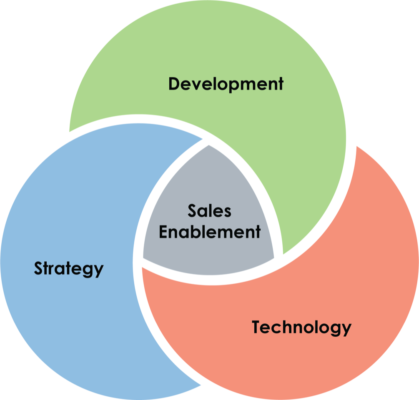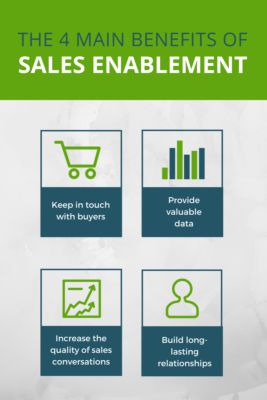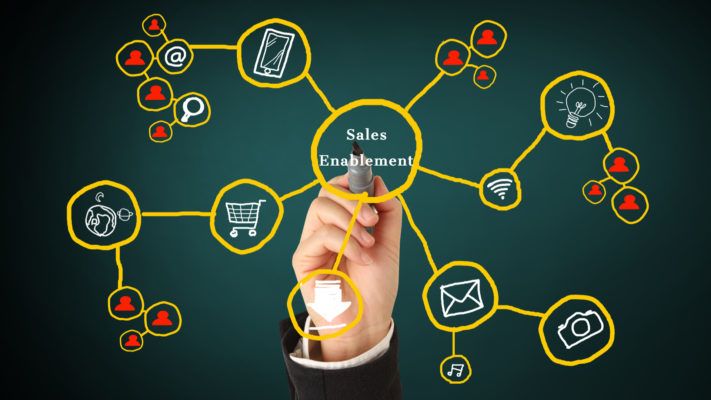If you work in sales, chances are you’ve recently heard the term sales enablement. Although it’s a hot topic, there seems to be some confusion around whether it’s just another vague buzzword or a specific field of practice that’s delivering real benefits to sales organizations.
With that in mind, we set out to answer four basic questions about it:
What is sales enablement?
Why is it important?
How is it practiced?
Who owns it?
WHAT IS SALES ENABLEMENT?
Sales enablement is the process of providing the sales organization with the information, content, and tools that help salespeople sell more effectively. The foundation of sales enablement is to provide salespeople with what they need to successfully engage the buyer throughout the buying process. A big part of sales enablement involves equipping salespeople with information they can use in sales cycles. This information might take the form of customer-facing content, sales best practices, and tools to name just a few examples. Regardless of the form the information takes, it needs to be easy to consume and reusable across the sales organization.

Let’s dissect this a bit by specifying the seven defining attributes of sales enablement:
The objective of sales enablement is straightforward. It’s about providing salespeople with the resources they need to sell more effectively. Of course, how you make this happen is a more complex discussion.
Sales enablement is less about sales and more about the buyer. The field of it is predicated on providing salespeople with what they need to engage their target buyers. As such, it’s important to remember a simple tenet – provide sales with the resources the buyer wants. It’s also important to understand when the buyer wants to leverage these resources.
What it provides to salespeople is a critical part of defining your program. What you provide usually takes the form of information. We group this information into two categories. First, there are things like content that sales will provide to the buyer. Second, there are things like best practices, research, and tools that sales will consume internally.
Another defining attribute of enablement is that salespeople must know how to use the resources you provide to them. That’s why training and development should be such a big part of most programs. The most effective programs conduct traditional training programs but also use technologies like collaboration tools to make sales training continuous.

One fundamental premise of it is that it helps all salespeople whether you have a sales organization of one or 1,000. Given that, you need to make sure that what you provide to salespeople is easy to use. When designing for usability, you should make resources easy to find and easy to apply. You want these resources to be used over and over again. This will only happen if they are high quality (see the previous point on the buyer and providing sales with things the buyer wants) and easy to use.
Whether the sales team uses what you provide is key. The best programs track and enforce whether resources are being used across the sales organization. Most importantly, they optimize future efforts based on what’s used and what’s not used.
The final defining characteristic of it is measurement. Some of the more meaningful metrics that you should track include average sales cycle length; the number of reps achieving quota; and average deal size. There are other metrics you can track, but these three are a good place to start.
One thing that most experts agree on is that sales enablement should start with a deep understanding of who the buyer is and what they want. In other words, effective is customer-centric. It’s a program that helps salespeople communicate more effectively with customers by providing them with the information and tools they need to provide buyers with what they want.

WHY IS SALES ENABLEMENT IMPORTANT?
Sales enablement delivers a really compelling benefit – it allows a large number of salespeople to achieve quota in a scalable, predictable, and repeatable fashion. Another way to put this is that it is designed to democratize the sales organization so that you’re no longer dependent on a handful of superheroes to hit the team quota. Yes, there will always be salespeople that have a natural ability to exceed quota, but how do you enable a broader spectrum of salespeople to achieve quota?
Sales enablement plays a key role in scaling the sales organization beyond a handful of over-achievers. It provides all salespeople with the best practices, knowledge, tools, and resources required to be successful. It’s essentially an effort to democratize what it takes to be a successful salesperson. In fact, one critical sales enablement best practice is to designate over-achievers as leaders/teachers of the program.
HOW IS IT PRACTICED?
There are a number of sales enablement best practices that can help you with your efforts, but in my opinion there are five that really matter:
Define and declare the specific objectives for your program. At a high level, your program should focus on helping sales people sell more effectively. This starts with providing sales people with everything they need to engage and convert buyers. But what do you focus on from there? Should you focus on detailed information about products and services? What about sharing best practices from top performers in the sales organization? How about the development of sales skills like delivering great presentations? These are all good options to consider and there’s no reason you just have to pick one.
Make the buyer’s experience the foundation of it. Given that this is about empowering to engage the buyer, it makes sense that you would make the buying experience the cornerstone of your efforts. There are two pieces to this. First, make sure that salespeople understand who the buyer is and the journey they’re on. Second, map your sales plays and training to the buying experience. This is just sales enablement 101.
Create and use a lot of high quality content. Content is quickly becoming the “force multiplier” of most modern sales organizations. Things like blog posts, white papers, and webinars allow a large number of sales people to deliver a lot of valuable to buyers in a scalable, controllable way. In fact, good salespeople are now using content as a crutch, preferring to let high quality content do the talking. So make sure your sales team has a lot of high quality content that maps to the buying process.
Make sales training an always-on, continuous effort. Sales training is a big part of sales enablement. It’s where salespeople learn how to sell more effectively. Most sales training programs suffer from a fatal flaw – they happen once a year. As a result, salespeople are quick to forget what they’ve learned, as well as the information, content, and tools they’ve been provided with. To combat this, you need to make sales training a continuous effort. You should conduct at least one formal training a month and use tools like newsletters and collaboration platforms to keep sales enablement in front of the sales team.
Ensure that sales people are leveraging what you provide. Even the best sales enablement programs can die a quick death if no one is watching how sales uses what’s provided to them. It’s critical that sales management enforce the use of best practices, content, and tools in the sales organization.

WHO OWNS?
Sales enablement is owned jointly by sales and marketing. There are a few simple organizational rules that can help you structure your program. First, both sales and marketing must collaborate on what resources are needed for the program. Common resource requirements include content, conversation guides, and sales training. Second, marketing is usually responsible for creating the vast majority of this information. Third, marketing should bear most of the responsibility for training the sales organization. Fourth, sales operations play a crucial role in “operationalizing” the information sales receive as part of the sales enablement program. Finally, it’s up to sales management to make sure that the sales enablement program is in fact being put into practice.
Some thought leaders posit that there be no separation between sales and marketing teams when it comes to sales enablement. This makes sense in an ideal state but is often unachievable in the real world. Even in the most integrated “revenue” organizations, there are usually distinct sales and marketing roles and responsibilities, as outlined above. When it comes to sales enablement, the best organizational rule is that marketing is a better creator and sales is a better enforcer.
There is one other organizational point to consider – sales enablement can and should be a mindset or part of the corporate culture. The old saying “you’re either in sales or you’re in sales support” highlights that you should either contribute to sales enablement or benefit from it. If we believe that sales enablement has a positive impact on revenue, then it goes without saying that all parts of the organization have a vested interest in the success of sales enablement. Companies that understand that all employees are involved in helping improve sales performance are the ones that truly grasp the meaning of sales enablement.
Related keywords: 0
Related post:


